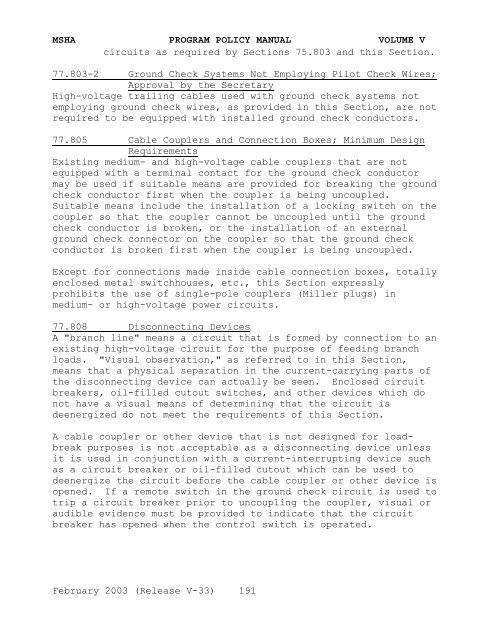Program Policy Manual - VOLUME V - Mine Safety and Health ...
Program Policy Manual - VOLUME V - Mine Safety and Health ...
Program Policy Manual - VOLUME V - Mine Safety and Health ...
You also want an ePaper? Increase the reach of your titles
YUMPU automatically turns print PDFs into web optimized ePapers that Google loves.
MSHA PROGRAM POLICY MANUAL <strong>VOLUME</strong> V<br />
circuits as required by Sections 75.803 <strong>and</strong> this Section.<br />
77.803-2 Ground Check Systems Not Employing Pilot Check Wires;<br />
Approval by the Secretary<br />
High-voltage trailing cables used with ground check systems not<br />
employing ground check wires, as provided in this Section, are not<br />
required to be equipped with installed ground check conductors.<br />
77.805 Cable Couplers <strong>and</strong> Connection Boxes; Minimum Design<br />
Requirements<br />
Existing medium- <strong>and</strong> high-voltage cable couplers that are not<br />
equipped with a terminal contact for the ground check conductor<br />
may be used if suitable means are provided for breaking the ground<br />
check conductor first when the coupler is being uncoupled.<br />
Suitable means include the installation of a locking switch on the<br />
coupler so that the coupler cannot be uncoupled until the ground<br />
check conductor is broken, or the installation of an external<br />
ground check connector on the coupler so that the ground check<br />
conductor is broken first when the coupler is being uncoupled.<br />
Except for connections made inside cable connection boxes, totally<br />
enclosed metal switchhouses, etc., this Section expressly<br />
prohibits the use of single-pole couplers (Miller plugs) in<br />
medium- or high-voltage power circuits.<br />
77.808 Disconnecting Devices<br />
A "branch line" means a circuit that is formed by connection to an<br />
existing high-voltage circuit for the purpose of feeding branch<br />
loads. "Visual observation," as referred to in this Section,<br />
means that a physical separation in the current-carrying parts of<br />
the disconnecting device can actually be seen. Enclosed circuit<br />
breakers, oil-filled cutout switches, <strong>and</strong> other devices which do<br />
not have a visual means of determining that the circuit is<br />
deenergized do not meet the requirements of this Section.<br />
A cable coupler or other device that is not designed for loadbreak<br />
purposes is not acceptable as a disconnecting device unless<br />
it is used in conjunction with a current-interrupting device such<br />
as a circuit breaker or oil-filled cutout which can be used to<br />
deenergize the circuit before the cable coupler or other device is<br />
opened. If a remote switch in the ground check circuit is used to<br />
trip a circuit breaker prior to uncoupling the coupler, visual or<br />
audible evidence must be provided to indicate that the circuit<br />
breaker has opened when the control switch is operated.<br />
February 2003 (Release V-33) 191
















